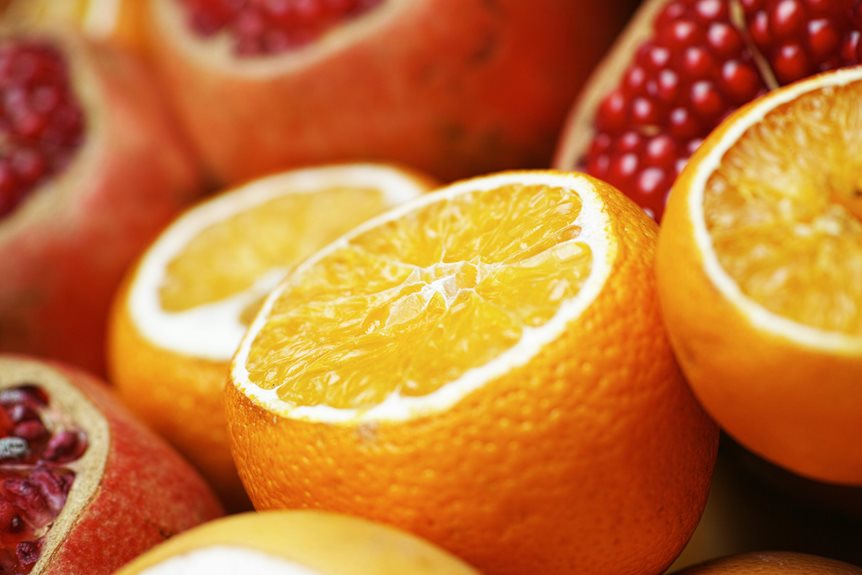To juice a pomegranate like a pro, you’ll need a blender, fine-mesh strainer, and airtight containers. Start by cutting around the crown and scoring the fruit along its natural ridges. Submerge segments in water and tap with a wooden spoon to release the seeds. Blend the collected arils in short pulses, strain the mixture, and store your fresh juice in glass containers for up to 5 days refrigerated. Master these essential steps to access every drop of this antioxidant-rich treasure.
Essential Tools for Fresh Pomegranate Juice
Three main categories of tools are essential for juicing pomegranates at home: blending equipment, straining tools, and storage containers.
You’ll need a quality blender with a secure lid and plunger to effectively pulse the pomegranate arils without crushing the seeds. For ideal control, use short pulses at low speed.
To separate juice from pulp, you’ll want either a fine mesh strainer, cheesecloth, or nut milk bag. A spoon helps press down on the pulp to extract maximum juice. Incorporating nutrient-rich juices from fresh fruits like pomegranates can enhance detoxification.
For storage, keep quart-sized Mason jars or airtight glass containers on hand. Using proper storage containers helps maintain freshness for up to six months when frozen.
Additional tools that’ll make your juicing process smoother include a paring knife and cutting board for initial pomegranate preparation.
If you’re planning to freeze arils, grab some parchment paper to prevent clumping.
Preparing Your Pomegranate for Juicing
Before diving into the juicing process, proper pomegranate preparation will greatly impact your juice’s quality and quantity.
Start by selecting a ripe pomegranate that feels heavy for its size and displays a deep red or pink color. Avoid fruits with soft spots, mold, or leathery skin.
Once you’ve chosen your pomegranate, wash it thoroughly under cold water and pat it completely dry with a clean towel. Using just a big wooden spoon for deseeding will make the process much easier. Set up your workspace with a deep bowl that has a pouring spout, and wear protective clothing to prevent stains.
Using a sharp paring knife or small chef’s knife, cut a shallow circular section around the crown. Then, score the fruit from top to bottom along the white pith lines, being careful not to cut too deeply and damage the seeds inside.
Breaking Down the Fruit and Collecting Seeds
Breaking down a pomegranate requires a systematic approach to maximize seed collection while minimizing mess. Start by slicing your pomegranate horizontally across its equator, then make a shallow circular cut around the crown. Follow the fruit’s natural ridges and white pith lines to segment it into manageable sections.
You’ll want to remove the crown and large central pulp, then separate the segments. To extract the seeds efficiently, hold each segment over a bowl of water and firmly tap the skin with a wooden spoon. The process works especially well since the seeds sink while lighter materials float.
The arils will fall into the water while the pith floats to the surface. Use a fine-mesh strainer to remove the floating pith, then drain and dry your seeds. This method guarantees you’ll collect clean, undamaged pomegranate seeds ready for juicing.
The Water Bowl Method for Clean Extraction
The water bowl method elevates pomegranate seed extraction to a mess-free experience.
Begin by placing your scored pomegranate in a deep bowl filled with water. As you pry open the fruit underwater, you’ll prevent juice from splashing onto your clothes or counters.
Break the pomegranate into wedges while submerged, then use your fingers to gently separate the seeds from the white membrane. You’ll notice the seeds sink to the bottom while the membrane floats to the top. Remember to check for and remove any discolored or orange arils that may affect juice quality.
Simply skim off the floating membrane and pour out the water, keeping the seeds in place.
Once you’ve collected all the seeds, pat them dry before proceeding with your preferred juicing method. This technique not only keeps your workspace clean but also guarantees you’ll get every valuable seed from your fruit.
Blending Techniques for Maximum Juice Yield
Mastering blender techniques reveals the full potential of your pomegranate arils.
Start by placing the arils in your blender and begin at low speed to maintain control. Use a plunger to push down any stray arils during the process, blending in short 1-2 second intervals. Remember that only arils are used for quality juice production, so remove any white membrane or rind before blending.
If you’re using a professional-grade blender like Vitamix, you can increase the speed, but watch carefully to avoid pulverizing the seeds. The key is finding the right balance between crushing the arils and preserving juice clarity.
Once you’ve finished blending, strain the mixture through a fine-mesh material over a bowl.
Press firmly on the remaining pulp to extract every last drop. You can store your fresh pomegranate juice in a glass bottle for up to five days in the refrigerator.
Straining and Filtering Your Fresh Juice
Once you’ve blended your pomegranate arils, proper straining and filtering techniques will guarantee a smooth, seed-free juice.
Line a fine-mesh strainer with cheesecloth and position it over a mixing bowl. Pour your blended mixture through, then gather the corners of the cheesecloth to form a sack and squeeze firmly to extract maximum juice.
For ideal clarity, avoid over-blending the seeds, as this can create unwanted cloudiness. Use quick pulses instead of continuous blending, and strain immediately after processing. Consider wearing an apron or dark clothing while straining to protect yourself from potential stains.
If you’re seeking ultra-smooth results, strain the juice a second time through fresh cheesecloth.
Remember to handle carefully, as pomegranate juice can stain. Transfer your filtered juice to a glass container with a tight-fitting lid for storage or immediate serving.
Storage Tips for Homemade Pomegranate Juice
Proper storage of your freshly squeezed pomegranate juice will preserve its nutritional value and vibrant flavor.
Store your juice in glass containers in the refrigerator for up to 5 days, keeping it away from direct sunlight to prevent nutrient loss through oxidation.
For long-term storage, freezing is your best option. Pour the juice into freezer-safe containers, leaving a half-inch of space at the top for expansion.
Your frozen pomegranate juice will maintain its quality for up to one year when stored in vapor-proof containers.
Always label your containers with the storage date, whether refrigerating or freezing.
Remember to store frozen containers upright until they’re completely frozen.
Consider making smaller batches of juice with vitamin C-rich fruits to enhance iron absorption and maximize nutritional benefits.




Konnichiwa! (Hello!) I'm Pat Tokuyama, a Japanese tofu cookbook author, who travels for music, food, and adventure. If you like Japanese tea, checkout some of the newestorganic japanese tea, matcha bowls and noren and more!
** Curious about the Plant Based Japanese Cooking Club? ** Learn more here!